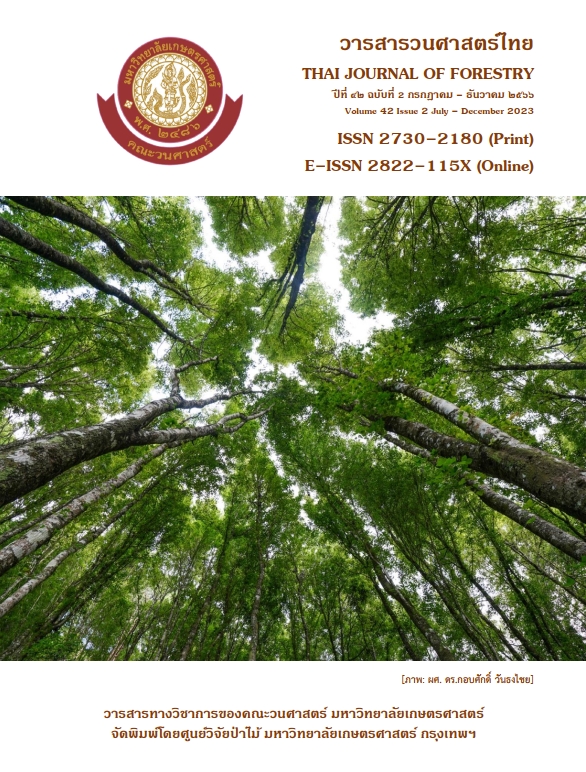ความหลากชนิดและการกักเก็บคาร์บอนในมวลชีวภาพของไม้ยืนต้นและไม้รุ่น ในป่าชุมชนบ้านหนองกวาง จังหวัดอุตรดิตถ์
Main Article Content
บทคัดย่อ
การศึกษาในครั้งนี้มีวัตถุประสงค์เพื่อวิเคราะห์ลักษณะสังคมพืชและปริมาณการกักเก็บคาร์บอนในมวลชีวภาพของไม้ต้นและไม้รุ่น ในพื้นที่ป่าเพื่อการใช้ประโยชน์ ณ ป่าชุมชนบ้านหนองกวาง จังหวัดอุตรดิตถ์ ซึ่งมีพื้นที่ขนาด 804 ไร่ ทำการวางแปลงตัวอย่างรูปสี่เหลี่ยมจัตุรัส ขนาด 40 เมตร x 40 เมตร จำนวน 10 แปลง ให้กระจายครอบคลุมไปพื้นที่ทั้ง 3 ชั้นคุณภาพลุ่มน้ำตามสัดส่วนพื้นที่ ทำการเก็บข้อมูลชนิดพรรณไม้ วัดขนาดเส้นผ่านศูนย์กลางที่ระดับอก (diameter at breast height: DBH) และความสูงทั้งหมดของไม้ต้นและไม้รุ่น จากนั้นจึงทำการวิเคราะห์ค่าดัชนีความสำคัญของพรรณไม้ ประมาณค่ามวลชีวภาพโดยใช้สมการแอลโลเมตรีและคำนวณหาปริมาณการกักเก็บคาร์บอนในมวลชีวภาพของไม้ต้นและไม้รุ่น
ผลการศึกษา พบพรรณไม้ต้น (tree) ทั้งหมดจำนวน 75 ชนิด จาก 61 สกุล 32 วงศ์ โดยพบพรรณไม้ในวงศ์เข็ม (Rubiaceae) มีจำนวนชนิดมากที่สุดคือ 9 ชนิด รองลงมาได้แก่วงศ์ถั่ว (Fabaceae) จำนวน 8 ชนิด วงศ์ยาง(Dipterocarpaceae) วงศ์มะม่วง (Anacardiaceae) วงศ์ปอ (Malvaceae) และวงศ์แค (Bignoniaceae) จำนวนวงศ์ละ 5 ชนิด และพรรณไม้ในวงศ์อื่น ๆ จำนวนน้อยกว่าวงศ์ละ 5 ชนิด โดยมีแดง (Xylia xylocarpa (Roxb.) W.Theob. var. xylocarpa) เป็นไม้เด่น มีค่าความหนาแน่นของไม้ต้นอยู่ระหว่าง 122.5–177.8 ต้น/ไร่ (765.63–1,111.25 ต้น/เฮกตาร์) ค่าดัชนีความหลากหลายของ Shannon – Wiener อยู่ระหว่าง 2.54 – 2.97 ปริมาณมวลชีวภาพรวม (เหนือพื้นดินและใต้พื้นดิน) มีค่าเฉลี่ยเท่ากับ 15.04–16.93 ตัน/ไร่ (94.00–105.81 ตัน/เฮกตาร์) ปริมาณมวลชีวภาพในแต่ละพื้นที่ชั้นคุณภาพลุ่มน้ำมีความแตกต่างอย่างไม่มีนัยสำคัญทางสถิติ (P>0.05) การกักเก็บคาร์บอนในมวลชีวภาพรวม (เหนือพื้นดินและใต้พื้นดิน) มีค่าเฉลี่ยเท่ากับ 7.07–7.96 ตันคาร์บอน/ไร่ (41.19–49.75 ตันคาร์บอน/เฮกตาร์) ปริมาณการกักเก็บคาร์บอนในมวลชีวภาพทั้งหมดเท่ากับ 6,087.93 ตันคาร์บอน คิดเป็น 22,322.41 ตันคาร์บอนไดออกไซด์เทียบเท่า ผลการศึกษานี้สามารถใช้เป็นข้อมูลค่าการกักเก็บคาร์บอนของกรณีฐานในการดำเนินโครงการลดก๊าซเรือนกระจกภาคสมัครใจตามมาตรฐานประเทศไทย (Thailand Voluntary Emission Reduction Program: T-VER)
Downloads
Article Details

อนุญาตภายใต้เงื่อนไข Creative Commons Attribution-NonCommercial-NoDerivatives 4.0 International License.
ข้าพเจ้าและผู้เขียนร่วม (ถ้ามี) ขอรับรองว่า ต้นฉบับที่เสนอมานี้ยังไม่เคยได้รับการตีพิมพ์และไม่ได้อยู่ในระหว่างกระบวนการพิจารณาตีพิมพ์ลงในวารสารหรือสิ่งตีพิมพ์อื่นใด ข้าพเจ้าและผู้เขียนร่วม (ถ้ามี) ยอมรับหลักเกณฑ์และเงื่อนไขการพิจารณาต้นฉบับ ทั้งยินยอมให้กองบรรณาธิการมีสิทธิ์พิจารณาและตรวจแก้ต้นฉบับได้ตามที่เห็นสมควร พร้อมนี้ขอมอบลิขสิทธิ์ผลงานที่ได้รับการตีพิมพ์ให้แก่วารสารวนศาสตร์ คณะวนศาสตร์ มหาวิทยาลัยเกษตรศาสตร์ กรณีมีการฟ้องร้องเรื่องการละเมิดลิขสิทธิ์เกี่ยวกับภาพ กราฟ ข้อความส่วนใดส่วนหนึ่ง หรือ ข้อคิดเห็นที่ปรากฏในผลงาน ให้เป็นความรับผิดชอบของข้าพเจ้าและผู้เขียนร่วม (ถ้ามี) แต่เพียงฝ่ายเดียว และหากข้าพเจ้าและผู้เขียนร่วม (ถ้ามี) ประสงค์ถอนบทความในระหว่างกระบวนการพิจารณาของทางวารสาร ข้าพเจ้าและผู้เขียนร่วม (ถ้ามี) ยินดีรับผิดชอบค่าใช้จ่ายทั้งหมดที่เกิดขึ้นในกระบวนการพิจารณาบทความนั้น”
เอกสารอ้างอิง
Boonrodklab, C., Teejuntuk, S. 2008. Structure and aboveground biomass of forest community in Doi Inthanon national park, Chiang Mai province, pp. 411-419. In Proceedings of 46th Kasetsart University Annual Conference (Natural Resources and Environment). Kasetsart University, Bangkok, Thailand. (in Thai)
Charoenniyom, A. 1989. Regeneration Process in a Mixed Deciduous Forest with Teak at Mae Huad, Changwat Lampang. M.S. Thesis, Kasetsart University, Bangkok, Thailand. (in Thai)
Department of National Parks, Wildlife and Plant Conservation (DNP). 2015. Climate Change and REDD Plus. Bangkok, Thailand. (in Thai)
Diloksumpun, S. 2007. Carbon sequestration of forests and global warming. Journal of Soil and Water Conservation. 22(3): 40-49. (in Thai)
IPCC. 2006. IPCC Guidelines for National Greenhouse Gas Inventories: Chapter 4 Forest Land. National Greenhouse Gas Inventories Programme. IGES, Japan.
Issaree, M. 1982. Primary Production of Plant Communities in Old Clearing Areas at Sakaerat Environmental Research Station, Pakthongchai, Nakhon Ratchasima. M.S. Thesis, Kasetsart University, Bangkok, Thailand. (in Thai)
Khamyong, N. 2009. Plant Species Diversity, Soil Characteristics and Carbon Accumulation in Different Forests, Doi Suthep-Pui National Park, Chiang Mai Province. M.S. Thesis, Chiang Mai University, Chiang Mai, Thailand. (in Thai)
Kutintara, U. 1999. Ecology Fundamental Basics in Forestry. Department of Forest Biology, Faculty of Forestry, Kasetsart University, Bangkok, Thailand. (in Thai)
Nuanurai, N. 2005. Comparison of Area Index, Above – Ground Biomass and Carbon Sequestration of Forest Ecosystems by Forest Inventory and Remote Sensing at Kaeng Krachan National Park, Thailand. M.S. Thesis, Chulalongkorn University, Bangkok, Thailand. (in Thai)
Nukool, T. 2002. Structural Characteristics of Three Forest Types at Khun Korn Waterfall Forest Park, Changwat Chiang Rai. M.S. Thesis, Kasetsart University, Bangkok, Thailand. (in Thai)
Ogawa, H., Yoda, K., Kira, T. 1965. A preliminary survey on the vegetation of Thailand. Nature and Life in SE Asia 1: 21-157.
Ounkerd, K., Sunthornhao, P., Puangchit, L. (2015). Valuation of carbon stock in trees at Khao Wong Community Forest, Chaiyaphum province. Thai Journal of Forestry, 34(1), 29–38.
Royal Forest Department (RFD). 2018. Ban Nong Kwang Community Forest Information. 35p. Bangkok, Thailand. (in Thai)
Royal Forest Department (RFD). 2022. Community Forest Project Approval Information. https://www.forest.go.th/community-extension/2017/02/02/ผลการอนุมัติโครงการป่า, 8 August 2022.
Shannon, C.E., Weaver, W. 1949. The mathematical theory of communication. Cited by Ludwig, J.A., Reynolds, J.H. 1988. Statistical Ecology: A Primer on Methods and Computing. John and Wiley & Sons Inc., New York, USA.
Thailand Greenhouse Gas Management Organization (TGO) (Public Organization). 2015. Reducing Emission from Deforestation and Forest Degradation and Enhancing Carbon Sequestration in Ban-Kong-Tabang community forest, Petchaburi Province (P-REDD+). https://ghgreduction.tgo.or.th/en/database-and-statistics/registered-projects/item/809-reducing-emission-from-deforestation-and-forest-degradation-and-enhancing-carbon-sequestration-in-ban-kong-tabang-community-forest-petchaburi-province-p-redd-in-ban-kong-tabang-community-forest-pe.html, 24 June 2023.
Thailand Greenhouse Gas Management Organization (TGO) (Public Organization). 2016. Thailand Voluntary Emission Reduction Program Reference Manual: Forestry and Agriculture Sector. Bangkok, Thailand. (in Thai)
Thailand Greenhouse Gas Management Organization (TGO) (Public Organization). 2021. Calculation for Carbon Sequestration (Number 4). Bangkok, Thailand. (in Thai)


